► Hyundai i30 N long-term test
► Brand’s first hot hatch
► It does the mundane, too
Month 7 of our Hyundai i30 N long-term test review: a racing farewell as we compare our hot hatch with the WTCR racer
This is the last report on life with our i30N long-term test car, and it really is a fond farewell; you know a car’s doing something right when your mood lifts every time you climb into the driver’s seat. But I never imagined I’d find myself getting into the passenger side alongside touring car racing legend Gabriele Tarquini. Let alone that I’d be doing so to learn a circuit before climbing into the driver’s seat of his Hyundai i30N TCR race car. Turning into a funny sort of day, this.
A few weeks before our i30N Performance is due to leave, I’m sat in an identical car in the pitlane at the Circuito Tazio Nuvolari in northern Italy. The only difference is that the steering wheel is on the other side, and Tarquini (below) is sat behind it, pushing the switch for track-friendly N mode and disabling the ESP.

The experienced Italian was recruited by Hyundai as lead test driver to develop a racing version of the new i30N for the burgeoning TCR global touring car racing class, with testing beginning in spring last year. And then the i30N won the first race it entered, in Tarquini’s hands.
‘The road car was already finished when I first drove it,’ he explains, ‘but I was very happy when I did – I knew we had a good base to work from.’
A slow-ish warm-up lap and then he’s straight on it, not to showboat, but to give me the most accurate idea possible of braking points at full pace, and gear choices, which are broadly the same in the road car as the racer. As you’d expect, he makes everything look inspiringly easy: ‘It’s all in the timing. You must brake late, carry on with the brakes until apex, then when you reduce the steering come back on the power progressively.’
We swap seats, and of course my timing’s not quite as good as his, like a hobby musician on stage after a maestro, but I’m impressed with the i30N road car (below). This is the first time I’ve driven one properly on a track and suddenly it all makes sense: N mode’s adaptive damper setting, far too firm for the road, makes for just-so body control on track, and the heavyweight steering brings a sense of rock-solid stability under braking. In the spirit in which it was conceived, the i30N’s warranty covers trackdays. Best get to a circuit as soon as possible.
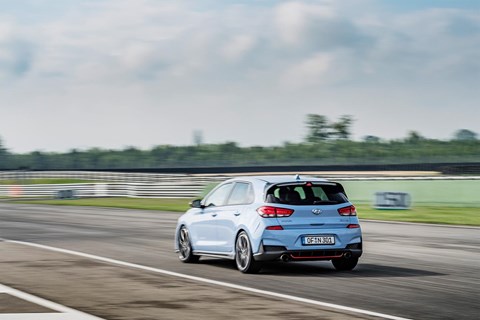
Then it’s the step up to the i30N TCR. It looks fantastic, all purposeful square stance, outboard aero flicks and aggressively cambered rear tyres on show through its open-ended box arches.
I’m belted into a superbly comfortable carbon race seat in front of a moulded facsimile of the road car’s dashboard, a blank space where the instruments would ordinarily be and a digital read-out mounted on the exposed steering column in their place.
The pedalbox and floor-mounted ballast on the empty passenger side say racing car, but it’s still clearly an i30 shell, still a road car beneath the tune-ups. TCR racing is all about cost-effective, production-based cars, and this racer is actually far closer to our long-termer than it is to the carbonfibre WTCC specials the new formula superseded.
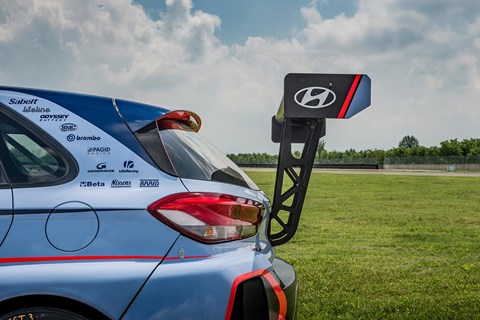
Drop from the in-built jacks, press the starter button and a resonant burr fills the whole car, the stripped-out cabin alive with noise and vibration. Thumbs up from the team, pneumatic paddleshift engages first, hill-start revs in anticipation of a racing clutch that turns out to be no less friendly than the road car’s, head for pitlane exit, and floor it.
The engine, a development of the one in our long-termer, sounds great – burly with a waspish, raspy overtone with whooshes and belches from the turbo off-throttle. Normally I fear cold rear tyres in front-wheel-drive racing cars like some people fear spiders (fronts get warm quickly, rears can stay treacherously slippy) but the i30 has great rear grip from the start, which Tarquini attributes to its rear suspension, a development of the road car’s multi-link components.
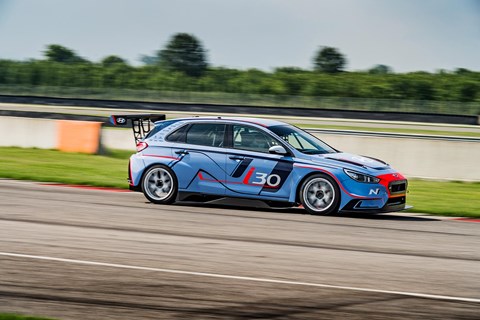
The car’s set-up has been changed very little from the one he would race with, and it’s wonderfully neutral, with a super-positive front end on turn-in but glued-down rear for great stability in corners slow and fast alike. Crucially, it’s not at all intimidating to drive, which means this car has nailed its design brief: it’s easy for amateur drivers, the foundation of TCR racing, to get to grips with at national level, yet capable enough for a pro like Tarquini to win at the highest international level. Less crucially, it’s also a heap of fun to drive. What a thing.
Anyway, back to the UK and back down to earth with a bump because it’s time to say goodbye to CAR’s i30N. It’s been an unexpected cracker. If the regular Hyundai i30 hatchback is grey porridge, the i30N is a full English with all the trimmings, a surprisingly capable and likeable performance car with a big character.
Downsides? It really is very thirsty. The knowledge that you will need to stop for fuel on a journey of any length soon gets annoying. As does a warning message that frequently flashed up on the instrument panel during rainy weather to say the automatic emergency braking system’s cameras are obscured. Fifth and sixth gears are reluctant to slot cleanly sometimes – a complaint other i30N drivers I’ve spoken to have also mentioned. The gurgling, gargling exhaust is a little too attention-seeking for me; I cringe every time I start the car up in a crowded place, but most other drivers crinkle into a smile – it talks a good talk.
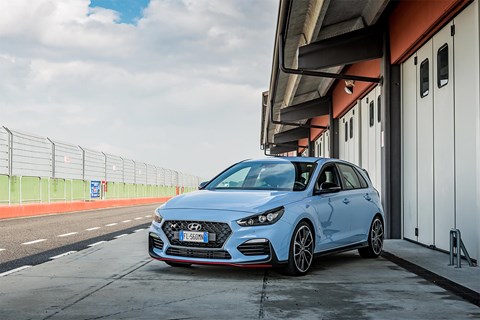
And walks the walk, too. At first I felt the ride was a bit too unforgiving, even in the adaptive dampers’ softest mode, and the steering prioritised artificial-feeling weight over feedback, but I grew used to both, and having now driven the i30N on track I’ve realised they’re both a fair trade for the car’s handling on the limit.
For all my nit-picking, there is an awful lot that is right about the N: driving position, properly thought-through ergonomics, unstinting standard equipment count, and the engine’s mix of muscle and flexibility. The i30N grew on me with every trip and I’ll miss driving it. It’s nice to have an alternative to the usual hot hatch suspects, and a good one at that. Just as with the racer, Hyundai’s N division has made a more than decent fist of its first effort, and in an era where the hot hatch bar is set higher than ever. Roll on the next N model…
By James Taylor
Count the cost: Hyundai i30 N depreciation
Cost new £28,580 (including £585 paint option)
Private sale price £22,050
Part-exchange price £20,790
Cost per mile 20p
Cost per mile including depreciation £1.07
Month 6 of our Hyundai i30 N long-term test: the driving position
Legend has it 1994 World Rally champion Didier Auriol once asked his bemused team to move his seat by 1mm, because he felt it would give him a greater connection with the road. The rest of us may not have a fraction of the driving skill of that 20-time WRC round winner, but we can all share Auriol’s view that a tiny change of driving position can have a disproportionate effect on how you drive.
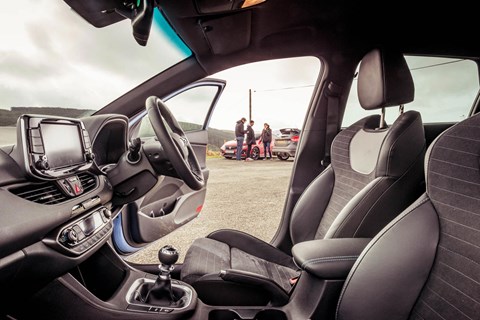
He’d probably approve of the sheer range of adjustment in the i30N Performance’s sports seats; their electric motors can tweak the backrest and lumbar support and, crucially, tilt the base by fractions of a degree until your driving position is just so.
And if you’re as serious about performance as Auriol, you could swap them for the base i30N model’s lighter, motor-less cloth seats instead.
By James Taylor
Month 5 living with a Hyundai i30 N: removal lorry duties
Being the good friend that I am, I’d agreed to give up my Sunday afternoon and help a pal pick up a dishwasher that absolutely was not going to fit in the back of his BMW 218d. Logic dictates that I should have chosen something large and probably SUVish, or, if I was being brave, a sporty estate.
However, we were due to have our Parkers Cheap Fast Car test the week after and I was keen to get an early go in one of the contenders. And, as it just so happened, James Taylor didn’t need the keys to his i30N that weekend.
A quick glance at the Performance Blue Hyundai’s boot, followed by the immortal words “it’ll be fine” and I was off, popping and cracking my way down the A1 thrilled at my choice of vehicle for the weekend’s activities.
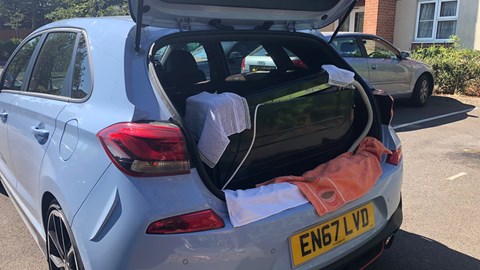
Now, I’m aware that the i30N’s seats-down boot capacity of 1,287 litres is smaller than most of its rivals (although it does shade the Golf R Hatchback), but even so this is a hot-hatch. It’s supposed to blend performance with practicality. Blitz the Sainsbury’s carpark and Snetterton 300 with equal aplomb. Therefore, it should have no problems with a simple dishwasher, right?
Well, sorry to disappoint those who were hoping for a calamitous tale on how I had to pick my way down the M27 with one of Bosch’s finest sticking out of the i30N’s boot, but it fitted. Rather nicely in fact.
Even the strut brace that I had planned to take out, but swiftly decided I wouldn’t when I realised tools would be need, wasn’t an issue. The horizontal bar actually providing a decent stopper for the large rectangular object that lay comfortably in the back.
I’d love to say that I then hooned it back with the dishwasher in the back – like a proper hot hatch driver – but sadly not. I took it easy, revelling in the improved ride provided by the white goods over the rear axle. Either the way, it was job done. The i30N had passed the ubiquitous practicality test. Who needs an SUV, eh?
By James Dennison
Month 4 of our Hyundai i30 N long-term test review: Nurburgring N24 or bust
A shirtless man is running towards us through the forest, wielding a searing red emergency flare above his head, his yells only just audible over a mechanical cacophony all around. Sounds like a climactic scene in a disaster movie, actually just another slightly crazy fan at one of the world’s crazier races: the Nürburgring 24 Hours.
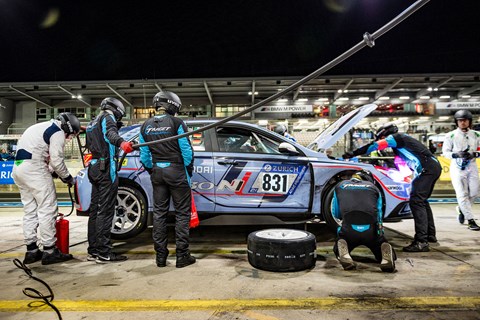
There’s no race quite like the N24: 150 cars, four times as many drivers, 900 marshals and a quarter of a million rabid spectators populating the forests around the 15.8-mile circuit. It’s not only a race but a giant festival of motorsport culture, and an event you simply have to experience at least once.
There’s no more full-on way to experience it than to camp at the circuit in the midst of the madness (or on the fringes of it, at least), and I drove CAR’s i30N over to Nürburg to do just that, sharing a campsite with Hyundai UK, there to support their touring car cousins. Hyundai Motorsport fielded a two-car i30N team in the TCR category (the N24 has a dizzying number of classes), and qualified one-two in class, lining up ahead of plenty of GT Porsches.

The i30 looks great in racing trim, all box arches and snowplough front splitter, and I reckon our long-term test car would look great on a set of those white competition wheels.
The man in charge of Hyundai’s N division, Albert Biermann, was in buoyant mood, an avuncular figure bouncing around the pits. ‘At first N stood for Namyang [Hyundai’s Korean R&D centre] but I suggested we combine it with Nürburgring because nobody knows Namyang! And we make a lot of big development decisions here, on the back roads and on the track. We have tons of wind tunnel data, but final decisions are made here – in corners where you need a big heart, the car must feel planted.’
As the race rages on and night falls, we trek through the forest to the banked Karussell turn. The further into the woods we get, the madder the camping pitches become: huge DIY viewing platforms built days before the race sprout live TV feeds, more sofas than a DFS sale and occasionally, somehow, running water. One pitch includes a hot tub, and I swear we see a functioning dishwasher. But the must-have installation in any N24 pitch is a giant sound system. Wailing Audi V10s and shrieking Aston V12s are far out-decibelled by speaker stacks blasting out every imaginable genre of music (but with hardcore techno a recurring theme). A makeshift club in a campsite with revellers dancing emphatically to a dance track with lyrics about Niki Lauda is an image that will stay with me forever.
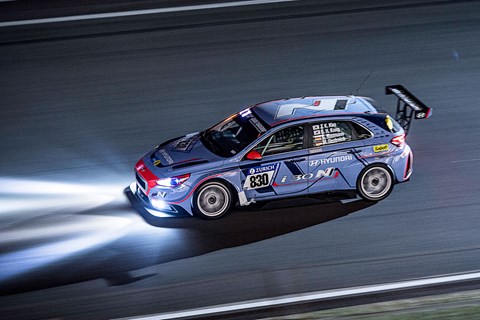
The slings and arrows of endurance racing meant Hyundai’s i30N racers finish second and fourth in class, in a finale obscured by mist and rain. The five-countries-in-one-day drive home feels unimaginable at first, but the i30N is a decent long-distance runner. The seats are supportive and adjustable enough to avoid a numb back, the stereo does a good job of drowning out road noise from the fat tyres, and Hyundai’s tuned the exhaust cleverly, snarling and gurgling at low revs but avoiding droning at cruising speeds.
Plenty of space on board too, enough for two tall occupants to use the same armrest without bumping elbows and to fill every cupholder and doorbin with road snacks with space to spare. Ride quality is better on smooth continental tarmac too, the i30N feeling taut rather than jiggly, as it can do on scarred British tarmac. Just a shame it’s so thirsty.
As we grind through traffic jams back in England in the wee small hours, I’m convinced the N24 is the best race in the world today. And the fact that our test car has a connection with it makes me feel even warmer towards the i30N.
By James Taylor
Logbook: Hyundai i30N Performance
Price £27,995
As tested £28,550
Engine 1998cc 16v turbo 4-cyl, 271bhp @ 6000rpm, 260lb ft @ 1500rpm
Transmission 6-speed manual, e-LSD, front-wheel drive
Performance 6.1sec 0-62mph, 155mph (limited), 163g/km CO2
Miles this month 1069
Total 5132
Our mpg 27.1
Official mpg 39.8
Fuel this month £256.09
Extra costs None
Month 3 of our Hyundai i30 N long-term test review: Performance Pack or not?
Our Hyundai i30N is the top Performance version: 271bhp, electronically controlled limited-slip diff, 19-inch wheels with big brakes, nice seats, £27,995. Worth it over the regular, £3k cheaper, 247bhp i30N? One way to find out.
Visually, our Performance’s bigger wheels fill its arches far more purposefully, like a bouncer in a doorway, but there are benefits to the base N’s smaller rims on the move. It rides a little more sweetly than our long-term test car, even though both versions have the same multi-mode adaptive dampers, and enjoys a slightly less enormous turning circle.
The regular i30 N is the white car below; ours is the hip pastel blue below.
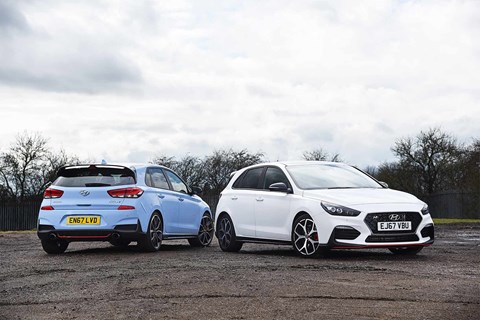
Both cars have the same torque output, and in a straight line they feel about as fast as each other. You do notice the absence of the Performance’s locking diff, but the i30N still finds plenty of traction through its torque vectoring by braking system, and feels similarly keen to turn in, despite its narrower tyres. Keener to oversteer, too.
You’ll probably have 90 per cent as much fun in the standard i30N, but the Performance does feel more special – the diff tugging at the steering, the pyrotechnics kit hidden in the active exhaust, and so on. On balance, it’s probably £3k well spent. Regular i30Ns might be a rare spot on the road as a result.
By James Taylor
Logbook: Hyundai i30N Performance
Price £27,995
As tested £28,550
Engine 1998cc 16v turbo 4-cyl, 271bhp @ 6000rpm, 260lb ft @ 1500rpm
Transmission 6-speed manual, e-LSD, front-wheel drive
Performance 6.1sec 0-62mph, 155mph (limited), 163g/km CO2
Miles this month 936
Total 3401
Our mpg 28.4
Official mpg 39.8
Fuel this month £198.35
Extra costs None
Diary update: Type R reflections
‘Why does your car sound like a bean can in a microwave?’ That’s the first thing my girlfriend asks when she gets into the i30 N long-termer I’ve borrowed for the royal wedding weekend, and it’s a pretty legitimate question. From the outside at least, the i30 N is aggressive but understated, and its WRC-esque engine note is one of few clues that point to just how lairy it can be. It’s also something I really prefer about the Hyundai when compared to my own Honda Civic Type R long-termer.
After a few months of exploring the limits of my Type R, I thought it was high time I jumped back into its most obvious rival. From motorway driving to demanding B-roads, I took the Hyundai everywhere from South London to Sussex, and it’s brought into focus all the good and bad things about my Type R.
Let’s get it out the way now. The Hyundai i30 N isn’t as fast as the Civic Type R, and on pretty much any road, the Honda will leave it for dead. But behind the wheel, for me at least, it’s probably the more rewarding car to drive. Like the GT86 or MX-5 we’ve been lucky enough to run this year, the i30 N isn’t about how fast you get somewhere, but more about the experience of getting there.
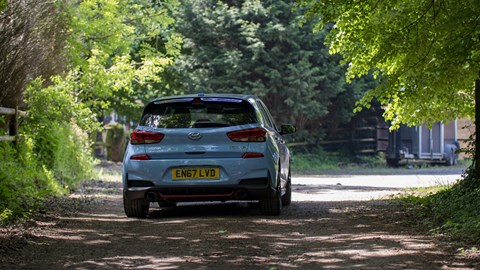
It’s just not as well mannered as the Honda, but isn’t a bit of silliness exactly what you want from a hot hatch? Where you can almost draw lines with the Type R at any speed, the Hyundai requires a bit of mid-corner adjustment – and where the Type R drags itself out of corners with absolute precision, the i30 N squirrels its way out with a dollop of torque steer and lively steering tug. It feels alive all the time, and you can make it misbehave at slower speeds, too.
The steering, while not as heavy or feedback-intensive as the Type R’s, is impressive as well, and the N’s uncompromising suspension gives you a full on HD impression of the road’s surface. When combined with that engine note, driving the Hyundai on the right roads is extremely satisfying – even if it’s at 90% of the Honda’s speed.
Not to say that the i30 N is slow. On slip roads and country lanes, the Hyundai is quick enough to give you a noticeable push back in your seat but the speed is piled on with a slightly less licence-losing risk than in the CTR.
And one of the best bits? Once you come to your senses or hit cruising speed, you just click away on the steering wheel buttons to put the Hyundai back into Eco mode. That gets rid of the excessive fuel consumption and the silly noise, too. If you want to give into the rally-esque warbles again, then N mode is right there on the wheel, goading you while you’re pottering down the high street.
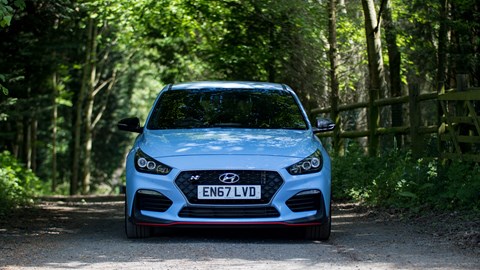
There are things to like apart from the handling and performance, though; the subtler i30 N doesn’t attract the negative attention the Honda does. Thanks to its pastel tones and lack of Marmite OTT body kit, the Hyundai only really makes its presence known when in N mode; with the exhaust note dialled down, it’s a certified sleeper car.
Would I trade my Honda for it? I’m not totally sure; the Civic Type R clearly has the better performance, and adaptive cruise control also makes it the slightly better car for longer journeys – but the i30 N is there or thereabouts. Throw in a roomy boot and serviceable infotainment system, and the i30 N makes sense for less cash (£27,995 plays the Honda’s £32,995 list price). So again, would I trade my Honda for it? I’m not sure, but I’ll be holding on to the keys for just a little longer.
By Curtis Moldrich
Diary update: why the Hyundai i30 N is the Goldilocks of the hot hatch world
I think the Hyundai i30 N might just be the Goldilocks of the hot hatch world: neither too OTT, brawny and embarrassing day-to-day (that’s you Civic Type R, maxi-Cupras and Ford Focus RS) nor too weedy and tepid to properly entertain.
Having just spent the weekend in our new pocket rocket from Korea, I came away impressed. It looks great, in that baby powder blue with subtle red accents and the interior is a lesson in restained sporting modesty. The chairs are grippy and just-so, the driving position is spot-on and the gearchange short of throw and pleasingly mechanical of slot. The graduated rev limiter (below) made me smile, reminding me of ex-BMW M man Albert Biermann’s influence.
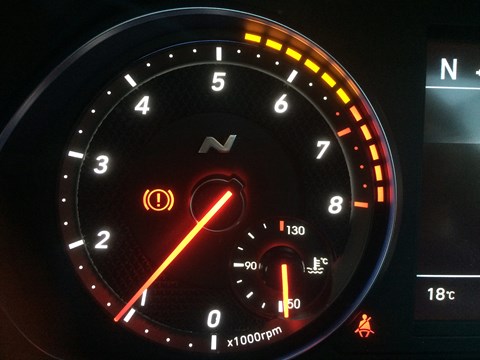
It all comes together on the road. The i30 N doesn’t actually feel that fast, which is telling. I mean, since when was 271 horsepower not enough? I think we’ve been spoiled, over-fed even, by an age of the 300bhp+ hot hatch.
But performance is exquisitely judged – fast enough to entertain and with a chunky, raspberry exhaust note popping and reverberating away. On overboost, it does feel properly rapid and the steering tugs away furiously in the lower gears, as the front axle struggles to cope with 279lb ft of twist torturing the 19in Pirellis. Yet on a motorway cruise, it relaxes to a surprisingly comfortable degree, only a slight patter from the big rims giving the game away.
Still, I just know there’s more in the can… i30 N R, anyone?
By Tim Pollard
Month 1 of our Hyundai i30 N long-term test review: the introduction
I’ve never been so excited to drive a new Hyundai. Actually, I’ve never been at all excited about driving any Hyundai. Which means the i30N has already been doing its job, even before it’s turned a wheel.
This is Hyundai’s first fully focused hot hatch (2011’s Veloster was a quasi-coupe oddball, 2015’s i30 Turbo a restrained warm hatch), and its mission is to broaden the brand’s image beyond being a maker of competent but nondescript transport for people who aren’t interested in cars. And there are more than a few reasons why you should be very interested in the i30 N.

Starting with the consonant after its name: N is the new high-performance sub-brand for Hyundai, and the i30 is its first product. Think of N as Cupra is to Seat, or M division is to BMW – the latter being particularly pertinent, because the man in charge of Hyundai’s N projects, Albert Biermann, was previously vice president of engineering at BMW’s blue ‘n’ red go-faster department. The i30N was already in progress before Biermann arrived, but he has played an important role in its sign-off. ‘N’ stands for two things, one being Namyang, Hyundai’s R&D centre in Korea, the other being Nürburgring. Hyundai has a dedicated test centre there; i30N prototypes have logged plenty of flying hours at the German circuit.
Like many modern hot hatches, the i30N is available in two grades of seriousness. The regular £24,995 car has 247bhp from its 2.0-litre turbocharged four-cylinder engine, 18-inch Michelins, and adaptive dampers with selectable modes. Our car is the £27,995 Performance version, which winds the power up to 271bhp, helping it get from zero to 62mph in 6.1sec (0.3 quicker), enlarges the brakes and brings N-specific 19-inch Pirelli tyres. It also adds an electronically controlled limited-slip differential, electric adjustment for the superbly comfortable sports seats, and an active exhaust system.
On start-up that exhaust growls like something in an enclosure at Longleat – the first clue that this is a hot hatch trained on the more hardcore end of the market. Another is the strut brace behind the back seats, spanning the gap between the rear arches and getting in the way if you need to drop the rear seats to carry big stuff.
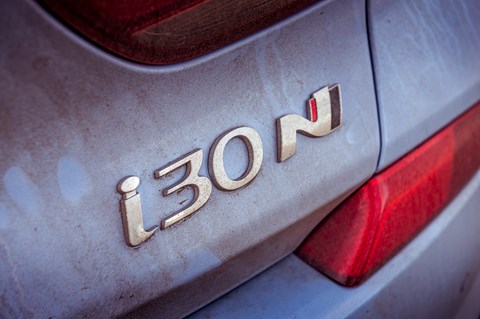
Slot the manual lever into first and release the manual handbrake (two big box-ticks for purist hot hatch fans – no auto ‘boxes or parking brakes in any i30N) and you’ll find the clutch has an abrupt bite to match the exhaust’s bark. The steering is heavy by modern standards, and the turning circle rubbish enough to make a fast Ford blush with pride.
Once you’re underway you’ll feel the e-diff gently tugging at the wheel as you exit a roundabout, and the ride is on the stern side of firm, even in the softest of the dampers’ selectable modes. This is a bit saucier than I’d expected.
Like sister company Kia, Hyundai doesn’t really do options – the only extra-cost equipment available for the i30N is a winter pack (heated seats and steering wheel – not fitted to our car) and metallic or pearl paint, or the Performance Blue our car’s finished in, a £585 option. It’s polarised office opinion, but it definitely makes the N stand out, with its contrasting red brake calipers and stripe of lipstick on the front bumper.
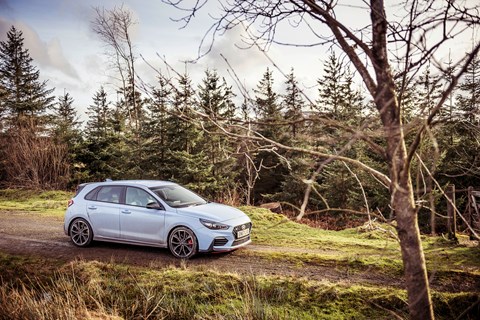
The lack of options doesn’t matter because the i30N wants for nothing in terms of kit. All versions, Performance or otherwise, get touchscreen nav with Apple CarPlay/Android Auto, wireless phone charging, keyless entry, cruise control, front and rear parking sensors, reversing camera and a space-saver spare wheel as standard. And the i30N still gets Hyundai’s five-year/unlimited mileage warranty, which also covers trackdays.
It feels like all the key ingredients for a proper driver’s car are in place. I’ve got an appointment with a B-road booked to find out for sure.
By James Taylor
Logbook: Hyundai i30 N Performance
Price £27,995
As tested £28,550
Engine 1998cc 16v turbo 4cyl, 271bhp @ 6000rpm, 260lb ft @ 1500rpm
Transmission 6-speed manual, e-LSD, front-wheel drive
Performance 6.1sec 0-62mph, 155mph (limited), 39.8mpg, 163g/km CO2
Miles this month 370
Total 1251
Our mpg 27.4
Official mpg 39.8
Fuel cost this month £97.55
Extra costs None